The Zebra Shark (Stegostoma fasciatum) is a species of carpet shark found in tropical waters around the world. Due to its unique patterning, it belongs to the family Stegostomatidae, and is sometimes referred to as a Leopard Shark.
Now, as intriguing and mesmerizing as their name is-there are so many fascinating facts about them that make one want to learn more. In this article, I will discuss them.
Zebra Shark at a Glance
| Category | Information |
| Common Names | Zebra Shark |
| Other Name | Leopard Shark, Stegostoma Shark |
| Scientific Name | Stegostoma fasciatum |
| Order | Orectolobiformes |
| Family | Stegostomatidae |
| Diet | Benthic invertebrates, small fish, crustaceans |
| Habitat | Coral reefs, sandy and muddy bottoms, shallow waters |
| Distribution | Western Pacific Ocean, Indian Ocean, and Red Sea |
| Size | Upto 12 feet |
| Weight | Up to 30 kilograms (65 lbs) |
| Life Expectancy | 25-30 years |
| Reproduction | Oviparous (lay eggs) |
| Conservation Status | Endangered |
The Zebra Shark (Stegostoma fasciatum) is a species of carpet shark found in the tropical waters of the Indian Ocean and the western Pacific Ocean. It is an active predator that feeds mainly on small fish, crustaceans, and mollusks.
The Zebra Shark has a slender body with a long snout and two dorsal fins located far back on its body. Its skin is covered with dark markings resembling stripes – hence its common name – and has striking white spots covering its head.
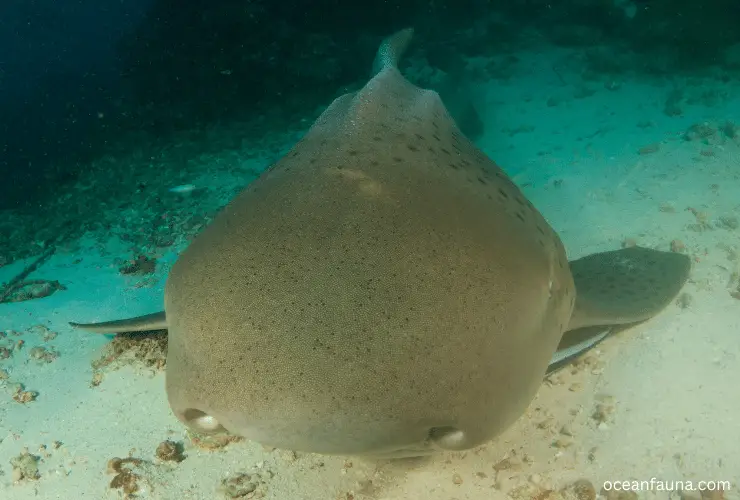
The Zebra Shark prefers shallow coastal waters, shallow coral reefs, lagoons, and deeper ocean floors where they can find hiding places among rocks or sand. During the day, they search for food while sleeping near the seafloor or hiding in crevices at night. Nocturnal animals actively swim around hunting for food during the night hours.
Read on to learn more about their anatomy, diet, habitat, reproduction, and others.
Fun Facts about Zebra Sharks
1. Zebra Shark got its name from the pattern of stripes or patches appearing on younger sharks’ bodies.
2. They reach sexual maturity around 5-7 years of age, which is longer than many other shark species.
3. Zebra sharks often swim in pairs or small groups.
4. During mating season, males and females can be observed performing a “dance” before mating. This courtship ritual involves the male biting the female gently on her pectoral fins to initiate copulation.
5. Zebra sharks are found in marine water. However, they can also survive in fresh and brackish water.
6. They are oviparous, meaning they lay eggs rather than give birth to live young.
7. Zebra sharks can survive for an hour out of the water if kept moist, which is a unique trait among sharks.
8. These sharks are also featured in a few movies, including Shark Tale.
9. The conservation status of the zebra shark is ‘endangered’ due to a variety of threats, including overfishing and habitat loss.
10. They have an average lifespan of 25-30 years in the wild.
How Zebra Shark Got Its Name?
The Zebra Shark (Stegostoma fasciatum) gets its name from the distinctive markings that adorn its brownish-grey skin, resembling the pattern of a zebra. These horizontal stripes are found on juvenile Zebra Sharks, fading to spots as they reach adulthood.
Through its unique coloring, behaviors, and predatory habits, the Zebra Shark has earned itself a reputation as one of nature’s most remarkable species – a claim that is backed up by its scientific name ‘Stigostoma Fasciatum’ which translates literally as ‘striped in bands.’
Though their unique patterns may appear only decorative, they have a purpose. The zebra-like markings are thought to help the shark blend into its environment, making it difficult for potential predators (or prey) to spot them.
This camouflage can also act as an effective warning system; when disturbed, the Zebra Shark often flashes its stripes in a defensive display.
Anatomy of Zebra Shark
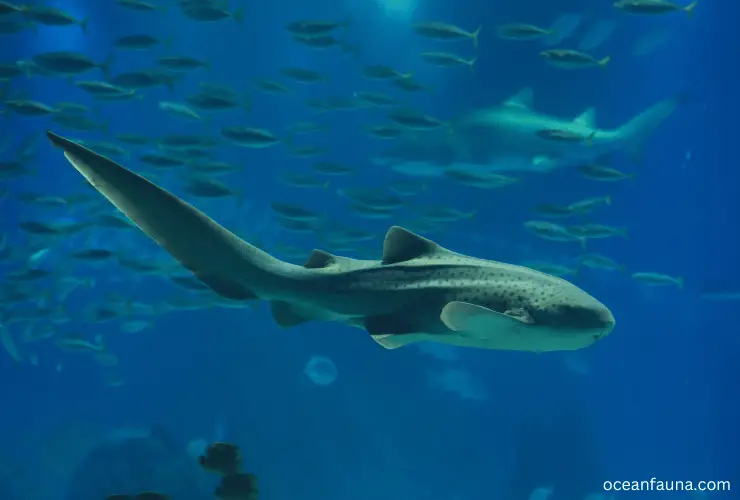
The zebra shark has a distinctive striped pattern that gives it its common name. This species can reach up to 12 feet in length but is typically much smaller, only growing to around 7.5 feet.
Its body is mainly gray with dark stripes running along its sides and back, which helps the fish to blend in with its environment when swimming near coral reefs and other rocky areas.
Skeletal System
The skeletal system of the zebra shark consists of cartilaginous bones and jointed appendages called fins. The skeleton supports the muscles, allowing them to move efficiently and protecting internal organs.
The head region includes:
- The skull houses the brain, eyes, and sensory organs.
- Jawbones with sharp teeth.
- Gill slits.
- An opening at the top of the head through which water enters and exits during respiration.
The vertebral column supports most of the body’s weight while providing flexibility for movement.
Digestive System
The digestive system of zebra sharks starts at the mouth, where food is ingested. The teeth are used to break down hard-shelled prey before passing it into the esophagus where it moves towards the stomach, where acids break down proteins into amino acids that tissues can absorb throughout the body.
From there, digested material passes into a muscular intestine where nutrients such as carbohydrates, fats, proteins, vitamins, and minerals are further broken down and absorbed before leaving through an anus located at the end of a long tube called the cloaca which also serves as an excretory organ for eliminating waste products from metabolism.
Respiratory System
The zebra shark’s respiratory system involves five pairs of gill slits located on either side of the head just behind the eyes. This allows for oxygenated water to enter and carbon dioxide waste products to escape through these openings using diffusion across specialized tissue membranes–the gills–via respiration.
Water is forced through their mouths or nostrils into their pharynx before entering their branchiostegal chamber. Gas exchange occurs between blood capillaries within each gill arch and oxygen in surrounding water particles.
This process removes carbon dioxide from blood cells while introducing oxygenated molecules into systemic circulation so that cells can function properly throughout all parts of their bodies, including heart muscle tissue and skeletal muscles necessary for locomotion in aquatic environments.
Circulatory System
The heart, blood vessels (arteries and veins), lymphatic vessels, and red blood cells are the main parts of a zebra shark’s circulatory system (RBCs).
Their hearts have two chambers. One chamber gets deoxygenated blood from the rest of the body, and the other pumps oxygenated blood to the rest of the body.
Cardiovascular efficiency depends a lot on the right balance of contraction and relaxation in both pump chambers. This creates pressure gradients between them so that red blood cells (RBCs) can move oxygen-rich blood between the pulmonary and systemic circulations without lowering cardiac output too much during exercise or rest.
This is mostly due to the complex vascular geometry in their arterial and venous networks, which provides a balanced supply and demand (e.g., skeletal muscles vs skin cells).
Nervous System
The nervous system of zebra sharks plays an important role in coordinating sensory information with motor responses so that organisms can react correctly to external stimuli or internal conditions like hunger or thirst.
These instincts are programmed deep within neural networks and are linked to certain behavior patterns during different stages of life, such as mating rhythms, etc., depending on the needs of each species to live successfully among other organisms.
How Big Is a Zebra Shark?
The overall size of a zebra shark can vary significantly, with the maximum reported size reaching nearly 12 feet (3.6 meters) in length. However, it is essential to note that this measurement represents an extreme outlier, and the majority of zebra sharks are considerably smaller.
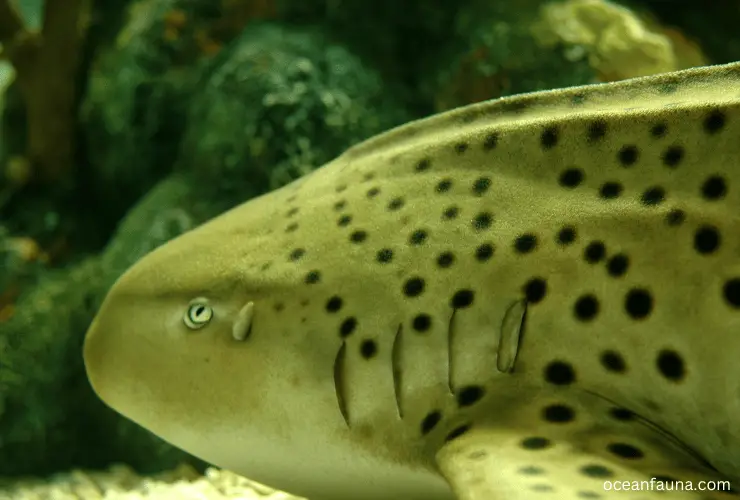
Adult zebra sharks typically measure between 6.5 and 11.5 feet (2 to 3.5 meters) in total length, with the average size falling around 7.5 feet (2.2 meters). This makes them a relatively medium-sized shark compared to other species, such as the whale shark – the largest fish on Earth – which can reach lengths of over 40 feet (12 meters).
In terms of weight, zebra sharks typically fall within the range of 45 to 65 pounds (20 to 30 kilograms), reinforcing their classification as a medium-sized species. As with most animals, factors such as diet, geographic location, and age contribute to variations in weight, with some individuals potentially weighing more or less than the reported range.
Furthermore, consider that female zebra sharks may be slightly larger than their male counterparts, a common occurrence in many shark species. This difference in size can serve various purposes, such as bearing larger offspring or exhibiting more effective predator evasion strategies.
What Do Zebra Sharks Eat?
Zebra sharks, also known as leopard sharks, feed mainly on benthic invertebrates such as mollusks, crustaceans, and small fish. Zebra sharks use their flexible body to squirm into narrow crevices and reef channels to search for food.
In the wild, zebra sharks typically hunt by patrolling the ocean floor, using their sensitive barbels around their mouths to detect prey within or under the sediment. They then grasp their prey with their powerful jaws and slash it with sharp saw-toothed teeth. Zebra sharks have also been documented using suction to capture small prey items near the ocean floor.
Nutritionally, zebra sharks get most of their energy from protein sources such as mollusks and crustaceans. These animals also contain essential fatty acids that provide energy and aid in maintaining health and vision.
Additionally, they consume small amounts of carbohydrates, such as sugars from algae present on the seafloor, which may provide an additional metabolic benefit.
Overall, zebra sharks are opportunistic predators that consume a wide variety of foods so long as they can fit through their flexible body cavities or leverage their strong jaw muscles and razor-sharp teeth to capture larger prey items like small fish.
Where Do Zebra Sharks Live?
Zebra Sharks (Stegostoma fasciatum) are primarily located in the warm tropical waters of the Western Pacific Ocean, Indian Ocean, and Red Sea. They have a wide geographic range, extending from Japan to the north, through Southeast Asia, down to Australia in the south, and stretching westward to cover the eastern coast of Africa.

These sharks are most commonly found in coral reef ecosystems, providing abundant suitable hunting grounds and shelter. In addition to coral reefs, they can also be found in sandy areas, estuaries, and around rocky habitats.
The availability of food sources and suitable habitats influences the distribution of the zebra shark. They prefer relatively shallow waters, typically occupying depths shallower than 200 feet (60 meters), although they have been found at depths of up to 330 feet (100 meters).
This preference for shallow water makes zebra sharks more likely to be found near coastlines, but they also inhabit areas around offshore reefs and atolls.
Coral reefs provide an ideal environment for zebra sharks due to the abundance of their preferred prey, which includes mollusks, crustaceans, and small fish. Their flexible bodies enable them to navigate through the complex structures of the reef, allowing them to access hard-to-reach prey found in the crevices and channels.
Zebra sharks are nocturnal feeders, and their ability to move gracefully through the coral structures while hunting at night is facilitated by their elongated bodies and elongated caudal, or tail, fins.
The habitats of zebra sharks change throughout their lives. While they are quite mobile, young zebra sharks remain in shallower water, seeking opportunities for prey and protection. Upon reaching maturity, they venture out into deeper waters, though they still stay within the coral reef ecosystems.
Zebra sharks are known to establish a particular range within the coral reef area, and they frequent specific locations within that range during the day to rest.
Temperature also plays a vital role in determining the distribution of zebra sharks. Their preference for warm water keeps them within the equatorial belt, typically between latitudes of 30°N and 30°S. As a result, zebra sharks are more commonly found in areas where water temperatures remain consistently warm throughout the year.
How Do Zebra Sharks Reproduce?
Zebra sharks reproduce through an oviparous process. During the mating season, male zebra sharks use their modified pelvic fins, known as claspers, to transfer sperm to a female. Afterward, the female lays up to four eggs at a time on a nesting surface.
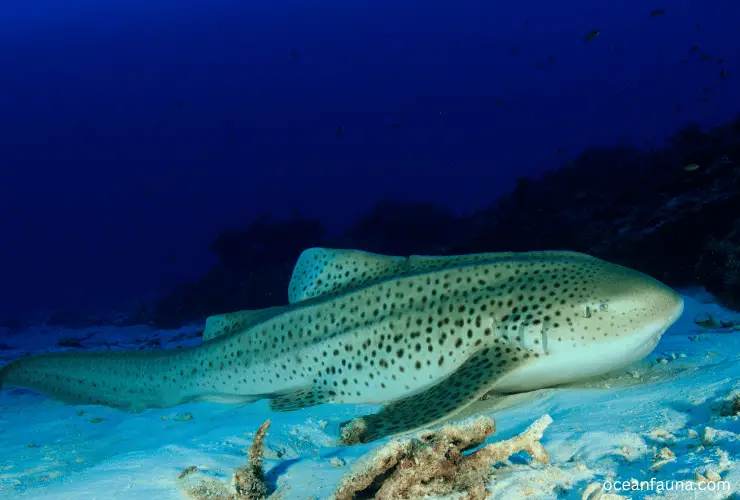
The egg cases are covered by fine fibers which anchor them to the surface for about six and a half months until hatching occurs. On average, one female can lay up to forty-six eggs each breeding season in over one hundred and twelve days.
The eggs are usually dark in color, ranging from browns to purples, and surrounded by a light layer of hairs that help keep them in place. When the eggs are ready to hatch, the embryos within them secrete an enzyme that breaks down the hair layer so they can emerge into open water.
Once hatched, young zebra sharks must immediately fend for themselves since their parents provide no parental care or protection; they must learn how to survive on their own shortly after leaving the egg case.
How Long Do Zebra Sharks Live?
Zebra sharks have a relatively long lifespan compared to other shark species. Generally, they are believed to live for 25 to 30 years. However, this estimate is influenced by various environmental and biological factors that affect their life expectancy.
Firstly, understand that zebra sharks grow and mature relatively slowly. They reach sexual maturity around 5 to 7 years of age. This is crucial to consider while assessing their overall lifespan, as the maturity rate may impact their life expectancy.
Studies have shown that, in some cases, zebra sharks that are well-adapted to their environment and have a plentiful supply of food may live longer.
Secondly, their habitat plays a vital role in determining their lifespan. Zebra sharks are primarily found in the warm waters of the Indian and Pacific Oceans. They inhabit shallow water near coral reefs, where they can find an array of prey, including crustaceans, mollusks, and small fish.
These shallow environments provide suitable hiding spots and ample food resources for these creatures, consequently increasing their chances of survival and longer lifespan.
Moreover, zebra sharks face several threats that can shorten their life expectancy. Some of these threats include overfishing, habitat degradation, and climate change.
Furthermore, the life expectancy of zebra sharks might be influenced by their adaptability and resilience. These sharks have shown remarkable abilities to adapt to changes in their environment throughout their life, enabling them to overcome challenges and survive in diverse ecosystems. This factor contributes to their relatively long lifespan compared to other shark species.
What Is the Conservation Status of Zebra Sharks?
Zebra sharks, also known as leopard sharks, are currently listed as “Endangered” on the International Union for Conservation of Nature’s Red List of Threatened Species. This is due to a variety of factors that have led to a decline in their population.
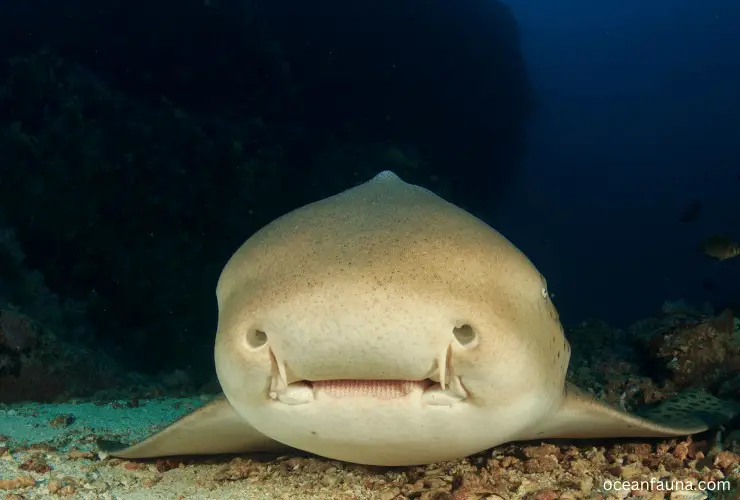
One major cause of the decline in zebra shark populations is overfishing. These sharks are often caught for their meat, their fins for shark fin soup, and their liver oil for use in supplements. The demand for these products has put significant pressure on the populations, particularly in areas with few fishing practices regulations.
In addition to overfishing, habitat loss and degradation have also contributed to the decline of zebra shark populations. These sharks prefer shallow, nearshore environments, but these areas are increasingly being impacted by coastal development, pollution, and other human activities. As a result, the sharks’ ability to find suitable habitats and reproduce successfully has been compromised.
Climate change may also be exacerbating the threats facing zebra sharks. Increasing water temperatures and other changes to ocean conditions could impact the availability and distribution of the sharks’ prey, which could have consequences for their survival in the long term.
Efforts are underway to protect zebra sharks, including establishing protected areas and fishing regulations. However, more work is needed to address the underlying causes of the species’ decline and ensure its long-term survival.
FAQs
Are Zebra Sharks Aggressive?
No, zebra sharks are generally not aggressive and remain peaceful when encountered by humans. They typically prefer to flee when threatened rather than attack or defend themselves. However, they may become more defensive if provoked or handled inappropriately.
Who eats zebra sharks?
Zebra sharks fall victim to bigger predators, yet humans are the primary hunters. Their meat is marketable in a variety of forms – fresh and salt-dried for direct consumption, as well as fishmeal used in other products.
Conclusion
Hopefully, you understand all the details about zebra sharks. I have discussed the importance of its conservation, some fun facts, and answered several frequently asked questions.
Apart from all these, if you have any other queries, let me know.


1 thought on “Zebra Shark: Habitat, Diet, Anatomy & Facts”